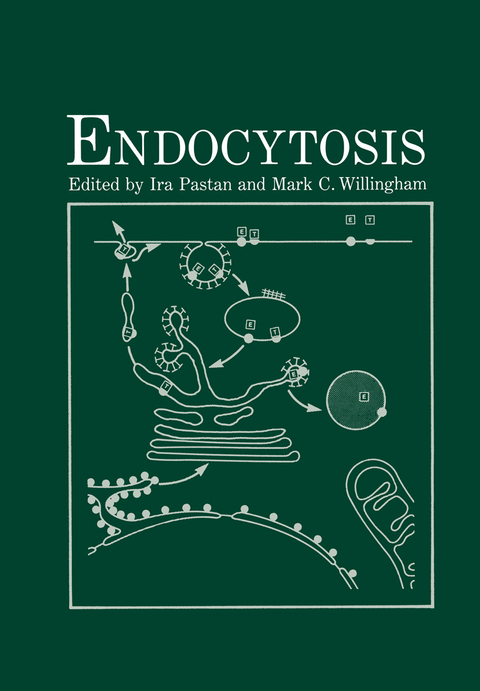
Endocytosis
Springer-Verlag New York Inc.
978-1-4615-6906-0 (ISBN)
1. The Pathway of Endocytosis.- 1. Introduction.- 2. Summary of the Pathway.- 3. History of Endocytosis.- 4. Ligands Internalized by Receptor-Mediated Endocytosis.- 5. Receptor Distribution.- 6. Receptosomes.- 7. Role of the Golgi System.- 8. Down-Regulation of Receptors.- 9. Why Ligands Enter Cells at Different Rates.- 10. Functions of Receptor-Mediated Endocytosis.- 11. Conclusions and Future Prospects.- References.- 2. Receptors.- 1. Scope of Receptorology.- 2. Receptor Organization.- 3. The Study of Receptors.- 4. Techniques of Ligand Binding to Receptors.- 5. Analysis of Binding Data.- 6. Receptor-to-Effector Coupling.- 7. Receptor Desensitization and Down-Regulation.- References.- 3. Chemical and Physical Properties of the Hepatic Receptor for Asialoglycoproteins.- 1. Introduction.- 2. Physical Properties.- 3. Requirement for Calcium.- 4. Determinants of Binding.- 5. Binding Kinetics.- 6. Dual Role of Sialic Acid.- 7. Receptor Distribution and Topology.- 8. Avian Hepatic Binding Protein.- 9. Perspectives.- References.- 4. The Structure of Clathrin-Coated Membranes: Assembly and Disassembly.- 1. Introduction.- 2. Isolation, Extraction, and Fractionation of Coated Vesicles and Their Components.- 3. Composition of Coated Vesicles.- 4. Clathrin Coat Dynamics.- 5. Conclusions.- References.- 5. Transferrin: Receptor-Mediated Endocytosis and Iron Delivery.- 1. Introduction.- 2. Structure of Transferrin.- 3. Function of Transferrin.- 4. Role of Transferrin in Biology and Medicine.- 5. The Transferrin Receptor: Biochemical Characterization.- 6. Cellular Binding and Uptake of Transferrin: Kinetic and Inhibitor Studies.- 7. Prelysosomal Divergence of EGF and Transferrin During Endocytosis.- 8. Role of a Prelysosomal Compartment in Transferrin-Bound Iron Release and Receptor-Bound Ligand Release.- 9. Biosynthesis and Recycling of Receptors: Two Roles for Secretion in Endocytosis?.- 10. Summary and Future Prospects.- References.- 6. POLYMERIC IgA AND GALACTOSE-SPECIFIC PATHWAYS IN RAT HEPATOCYTES: EVIDENCE FOR INTRACELLULAR LIGAND SORTING.- 1. Introduction.- 2. Receptor-Mediated Endocytosis in Rat Hepatocytes.- 3. Methodology.- 4. Fate of Secretory Component and Galactose-Specific Receptors.- 5. Pathways of Polymeric IgA and of Galactose-Exposing Derivatives in Rat Hepatocytes: Ultrastructural Studies.- 6. Intracellular Ligand Sorting in Rat Hepatocytes.- 7. Mechanism of Ligand and Receptor Sorting.- 8. Properties of Ligand-Sorting Organelles.- 9. Conclusions and Perspectives.- References.- 7. Toxins.- 1. Introduction.- 2. Toxin Structure.- 3. Intracellular Action.- 4. Function of the Cell Surface Binding Sites.- 5. Endocytosis and Transport of Toxin-Containing Vesicles.- 6. Requirements for Toxin Exit from Intracellular Vesicles.- 7. Conclusions.- References.- 8. Acidification of Endocytic Vesicles and Lysosomes.- 1. Introduction.- 2. Measurement of pH.- 3. Lysosomal pH.- 4. Endocytic Vesicle pH.- 5. Mechanism of Acidification.- 6. Summary.- References.- 9. Mathematical Modeling of Receptor-Mediated Endocytosis.- 1. Introduction.- 2. General Considerations of the Endocytic Pathway.- 3. General Models of the Endocytosis of Asialoglycoproteins.- 4. Surface Events and Internalization.- References.- 10. Morphologic Methods in the Study of Endocytosis in Cultured Cells.- 1. Introduction.- 2. Cytochemical Markers.- 3. Light Microscopic Fluorescence and Image Intensification Methods.- 4. Electron Microscopic Morphologic Methods.- 5 Immunocytochemistry.- 6. Direct Mechanical Microinjection Methods.- 7. Experimental Protocols for the Study of Endocytosis.- References.
| Zusatzinfo | 161 Illustrations, black and white; XVIII, 326 p. 161 illus. |
|---|---|
| Verlagsort | New York, NY |
| Sprache | englisch |
| Maße | 178 x 254 mm |
| Themenwelt | Studium ► 1. Studienabschnitt (Vorklinik) ► Anatomie / Neuroanatomie |
| ISBN-10 | 1-4615-6906-0 / 1461569060 |
| ISBN-13 | 978-1-4615-6906-0 / 9781461569060 |
| Zustand | Neuware |
| Haben Sie eine Frage zum Produkt? |
aus dem Bereich


